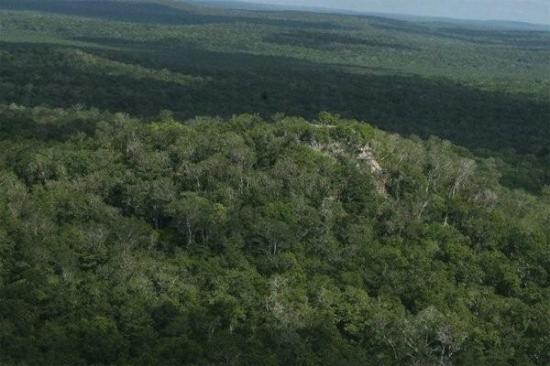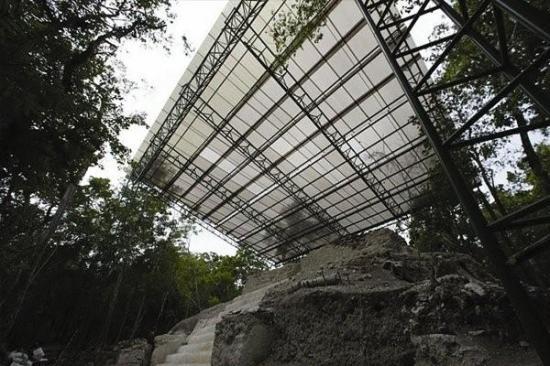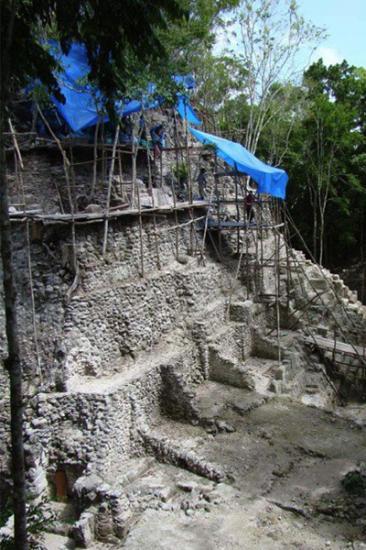El Mirador, Guatemala- Saving the Cradle of Mayan Civilization
Global Heritage Fund
Source - http://www.guatemala-times.com/culture/maya/2052-el-mirador-guatemala-saving-the-cradle-of-mayan-civilization.html
At the heart of the Maya Biosphere Reserve in northern Guatemala, shrouded by the last tract of virgin rainforest remaining in Central America, lies what many archaeology experts refer to as the Cradle of Mayan Civilization. Known officially as the Mirador Basin, the site is home to dozens of Mesoamerica’s earliest, largest, and most striking examples of Preclassic Mayan civilization, as well as La Danta, the largest pyramid by volume in the world. But according to the World Wildlife Fund, the Maya Biosphere has lost 70 percent of its forests in the last decade, and El Mirador itself has been threatened by wildfires, looting, poaching, narcotics trafficking, and other dangers.

Since 2003, Global Heritage Fund (GHF) has been working in Mirador to protect its priceless ancient cities and monuments and preserve the site for future generations. Led by project director Dr. Richard Hansen, founder and president of the Foundation for Anthropological Research and Environmental Studies (FARES), GHF primary goal is to establish a new 880,000-acre national park in the area and continues to work with local communities like nearby Carmelita to ensure Mirador’s integrity and sustainability. In 2010, after completion of site conservation, El Mirador opened to the public for the first time.
THREATS TO MIRADOR
For decades, Mirador has been plagued by an array of threats. Chief among these is deforestation, caused in large part by drug trafficking profits which have fueled a massive ranching industry that requires large areas of jungle to be cleared, and which have virtually destroyed the Maya Biosphere. Forest is also cleared for agricultural purposes, generally in a slash-and-burn practice that employs fire to clear the land. This practice has been so extensive, though, that the intensity of the fires and the resulting smoke has forced the closure of schools as far north as Texas. (Global Heritage Network (GHN) GHF’s new early warning and threat monitoring system for endangered sites in the developing world, has been used to track wildfires.)

Illegal logging has also had a devastating effect on the Mirador Basin, as looters and poachers not only hack through forest to navigate the site, but consequently block access roads needed to clear fallen trees. Looters, as well, have targeted and compromised virtually every site in the Mirador Basin, seizing their piece of a Mayan artifacts-trafficking industry that accounts for millions of dollars in the collecting markets each month (though extremely little of this lands in the pockets of looters). Indeed, only a fraction of the sites at Mirador have been studied by archaeologists thus far, and according to Dr. Hansen, “By the time scholars get there, looters may already have plundered them.”
GHF PROGRESS
When GHF began work at Mirador in 2003, its primary conservation goals were to establish permanent protection for the Mirador Basin, create a sustainable protected area within 10 years, and aid the Guatemalan government in securing a UNESCO World Heritage Site inscription for the 880,000 acre site, the largest of its kind in Central America. In 2011, GHF continues its preparations for the Archaeological Management Plan for the Mirador Natural and Cultural System, while extensive mapping of all major sites and causeways continues.
Conservation efforts at Mirador have been aimed predominately at stabilizing and preserving the site’s most significant monuments, including the complex of La Danta, the pyramid of El Tigre, and a building known as “Jaguar Paw Temple.” In 2010, GHF completed site conservation, and El Mirador opened to the public for the first time.
“Preservation by Design” is how GHF terms its integrated conservation and development methodology — a living framework that combines long-range planning, conservation science, community engagement, and monitoring and evaluation to ensure the future sustainability of each project site. At Mirador, GHF has equipped and trained 60 guides in the community association and funded Mirador’s 30 park rangers who have been relied upon to police illegal activities taking place within the protected area. In the gateway village of Carmelita, the town’s first ever water system has been implemented and a Visitor Center opened. GHF has also provided 45 computers with custom-designed courses for students and adults on conservation, nature, wildlife, archaeology, history, tour guiding and park ranger training.

“It is a great privilege to partner with Global Heritage Fund in our efforts to save Mirador, a nearly one-million-acre natural and cultural protected area,” says Fernando Paiz, Chairman of The Foundation of Cultural and Natural Maya Patrimony (PACUNAM). “Global Heritage Fund's Preservation by Design methodology and technical expertise in master planning and building international partnerships has helped to create a sustainable framework to increase food production and bring access to financing for thousands of hunger-afflicted people.”
PARTNERS IN CONSERVATION
GHF’s main partners on the Mirador project have been FARES, founded by project director and eminent archaeologist Dr. Hansen, who in 2005 was given the National Order of the Cultural Patrimony of Guatemala, and PACUNAM, an association that includes some of Central America’s leading businesses. Serving as a new model for private-public partnerships, PACUNAM looks to become Guatemala’s leading foundation in the preservation of Mayan natural and cultural heritage by combining the efforts of companies, businessmen, and individuals. This is the first time that major industrial groups have combined forces in Guatemala to realize a major new national park and conservation program for cultural and natural heritage of the country.
Mr. Paiz, former Chairman of the Board of Trustees for Wal-Mart Central America, says, “Global Heritage Fund has enabled our entire country—top companies, foundations, the government and community stakeholders—to work together towards a common vision for the successful long-term conservation of Mirador. GHF’s expertise in planning, partnerships and community development has been critical to our success.”
Kurt Vogt, Managing Director of Citi Latin America, says, “For five years, Citibank has entrusted Global Heritage Fund with our resources to preserve heritage and bring the benefits of economic development from heritage to the poorest regions of the world. Thanks to our continued partnership, Citi's investments are enabling large-scale conservation and sustainable development of major sites like Mirador.”
In 2009-2010, GHF received significant support and funding from its project partners, including the United States Department of the Interior, which secured approximately $1 million for conservation and other related projects in the Mirador Basin. The Foundation for Sustainable Development (FUNDESA) granted $1.2 million in funding for tourism development and community infrastructure, while GHF itself secured $6 million to go along with $3 million from the Guatemalan private sector (PACUNAM) and $4 million from the Guatemalan government and IDB for training and park infrastructure.
The Guatemalan government is committing major new investments in park infrastructure, social services, security, and park management. President Colom estimates that the project will generate thousands of new jobs and will be a critical initiative to stop the destruction of the Maya Biosphere Reserv
JUAN CARLOS’ STORY
Juan Carlos Calderon grew up in the village of Carmelita, a small and remote community of 200 bordering Mirador Rio Azul National Park in the Peten region of Guatemala. Uneducated, unemployed, and faced with basic human responsibilities of sheltering and feeding his family, Juan Carlos subsisted on a life of wildlife poaching and looting in the numerous Mayan ruins that surrounded his home. In dire circumstances like these, how could Juan Carlos be aware of the cultural and natural importance of these areas? How could he know that, if properly protected, these ruins could in turn help protect him and his family?
Since 2003, GHF has led an integrated program of planning, scientific conservation, community development and funding at Mirador. For the last five years, Juan Carlos has worked as a guard in the park. Today, with a job that provides him with a steady income, access to basic health care, and education opportunities (he has completed basic literacy programs at the Mirador Project camp), Juan Carlos now defends the very assets he plundered for much of his life. Most importantly, thanks to his new income, his eldest son Enrique completed high school and is studying law at university in Guatemala City.
Photos: Courtesy Global Heritage Fund
Photo 1: Danta Pyramid, Photo 2: Conservation, Photo 3: Stabilization